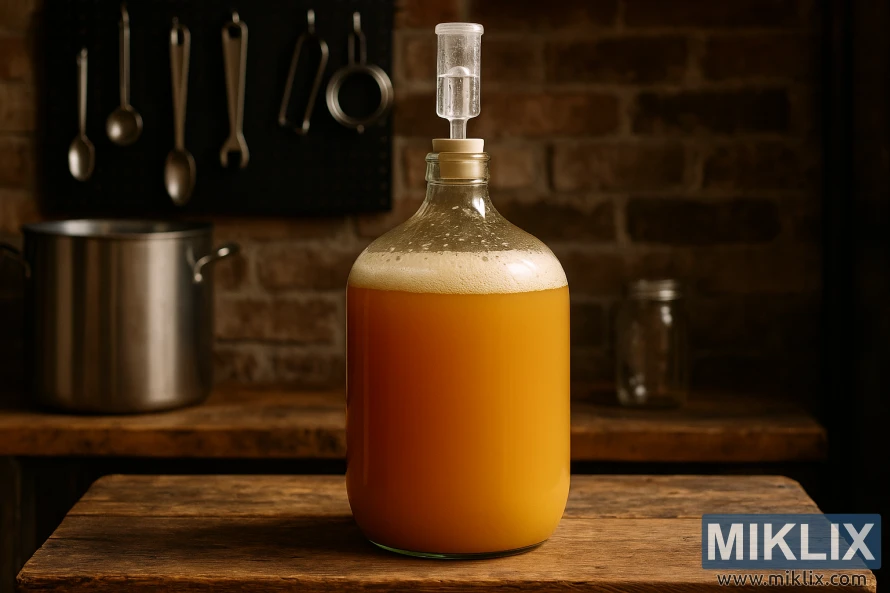Image: Hazy New England IPA Fermenting in a Rustic Homebrew Carboy
Published: October 16, 2025 at 7:12:48 PM UTC
A rustic homebrewing scene featuring a glass carboy fermenting a hazy New England IPA on a wooden bench, framed by a brick wall, stainless brew kettle, and brewing tools.
The image depicts a warm, rustic homebrewing environment centered around a glass carboy filled with a hazy, golden-orange liquid: a New England IPA in the process of fermentation. The carboy, bulbous and transparent, rests firmly on a weathered wooden workbench that shows decades of use, its surface marked with scratches, stains, and a natural patina that tells the story of countless brewing sessions. Inside the carboy, the beer glows softly with a juicy, opaque hue, characteristic of the NEIPA style, its cloudiness created by suspended hop oils, proteins, and yeast. A frothy, uneven krausen forms a creamy layer across the surface of the fermenting wort, giving visual evidence of the yeast working actively to transform sugars into alcohol and carbon dioxide.
Capping the carboy is a snug-fitting rubber stopper holding an airlock filled with liquid. The airlock, transparent and simple, is the essential device that allows carbon dioxide to escape while preventing oxygen and contaminants from entering. Its clean presence contrasts with the organic chaos of the foam and haze inside the vessel. Light reflects off the glass, adding dimensionality and emphasizing the thickness of the fermenting beer within.
Behind the carboy, the backdrop evokes a distinctly American DIY brewing environment. A pegboard is mounted against a rustic red-brick wall, holding polished stainless steel brewing utensils: long-handled spoons, a whisk, a funnel, and measuring tools, each gleaming faintly in the warm ambient light. To the left, partially out of focus, a large stainless steel brew kettle sits on the bench, hinting at the earlier stages of the brewing process—mashing, boiling, and hopping—all steps that precede fermentation. On the far right, a mason jar rests on a shelf, a quiet reminder of the traditional, handcrafted aesthetic that homebrewers often embrace, tying modern brewing equipment to older rural traditions of self-sufficiency.
The lighting in the scene is warm, natural, and slightly moody, creating a soft interplay of shadows and highlights. The brick wall, with its rough texture and earthy tones, contributes to the atmosphere of authenticity and craftsmanship. The photograph captures not just a technical process but also a cultural and sensory one: the anticipation of brewing, the tactile joy of craft, and the promise of flavor soon to come. The golden haze of the beer is both inviting and mysterious, suggesting notes of citrus, tropical fruit, and soft malt sweetness—all hallmarks of the hazy IPA style.
Overall, the image embodies the intersection of art and science that defines homebrewing. It is a portrait of patience and tradition, a still life that celebrates fermentation as a living process. The carboy becomes both a vessel and a symbol: transparent enough to reveal the haze and foam within, yet opaque with the promise of transformation, embodying the rustic spirit of American craft brewing.
The image is related to: Fermenting Beer with White Labs WLP095 Burlington Ale Yeast

